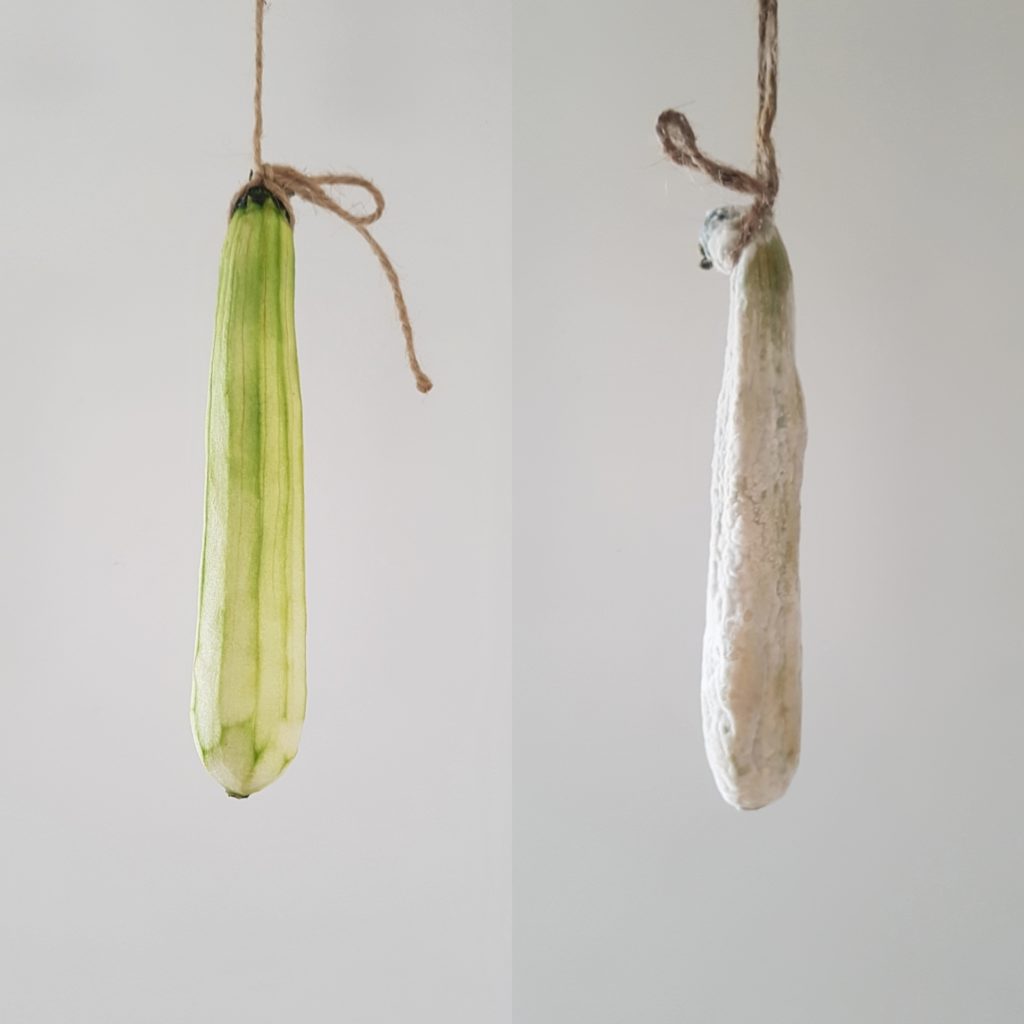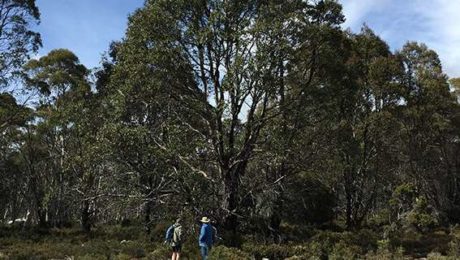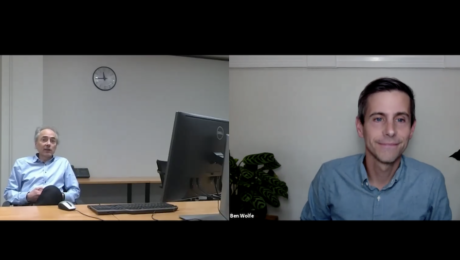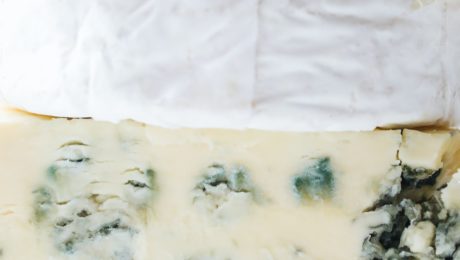The Science Behind Stinky Cheese
There’s a scientific reason behind the distinctly funky smells from cheese — it’s how microbes feed and communicate with each other. “What they’re saying has a lot to do with the delicious variety of flavors that cheese has to offer,” reads a statement from Tufts University, where the research was conducted. “The research team found that common bacteria essential to ripening cheese can sense and respond to compounds produced by fungi in the rind and released into the air, enhancing the growth of some species of bacteria over others. The composition of bacteria, yeast and fungi that make up the cheese microbiome is critical to flavor and quality of the cheese, so figuring out how that can be controlled or modified adds science to the art of cheese making.”
One of the authors of the study, Benjamin Wolfe, professor of biology at Tufts and TFA board member, said the research is noteworthy because “how these aromas impact the biology of the cheese microbiome had not been studied.” The findings will impact other fields, too.
Results were published in the journal Environmental Microbiology. The research was supported by a grant from the National Science Foundation.
Read more (Tufts University)
- Published in Science
Chocolate: Part of a Healthy Diet or Guilty Pleasure?
Does chocolate have a place in a healthy diet or is it a guilty pleasure? A new study found chocolate is good for the heart in moderate amounts. The study, printed in the European Journal of Preventative Cardiology, found eating chocolate more than once a week is associated with an 8% decrease in risk of coronary artery disease compared to those who eat chocolate less. Researchers note there are limitations — like the study didn’t account for type of chocolate or portion size. High-quality, low-sugar, dark chocolate, which is made with fermented cacao beans, has shown health benefits in other research.
Many major chocolate companies are trying to tout chocolate as a health food. Last year, chocolate producer Barry Callebaut petitioned the Food and Drug Administration to qualify the health claim that chocolate has heart benefits. The regulatory agency is still reviewing the request. This is the second time the Swiss company has petitioned the FDS to consider chocolate as a health food, but they were denied their first request in 2013.
Read more (Food Dive)
- Published in Food & Flavor, Science
The Science Behind Indigenous Wine
Australian wine scientists have published results of their research into the traditional practices Australian Aboriginal people used to make fermented beverages. Published in Scientific Reports, scientists from the University of Adelaide and the Australian Wine Research Institute (AWRI) “have discovered the complex microbial communities associated with the natural fermentation of sap from the iconic Tasmanian cider gum, Eucalyptus gunni.” The sweet sap from the trees produce a mildly alcoholic beverage when given time to spontaneously ferment.
Research leader Professor Vladimir Jiranek, Professor of Oenology with the University’s School of Agriculture, Food and Wine, says: “The wider community is not typically aware of these historic traditions. This work shines a light on these practices and the cultural significance of these unique fermentations. It also allows us to identify new strains, or species, of yeast and bacteria from the fermentations that are unique to Australia. Further work will characterize single microorganisms that have been isolated and grown from the cider gum. We are particularly interested in their fermentative abilities, their potential flavor impacts, how they’ve adapted to the cider gum environment and the possible symbiotic relationship they have with the trees. We look forward to continuing our work with relevant Aboriginal communities in order to understand these and other processes, and help revive lost practices or perhaps develop new ones from these.” (Phys.org) https://bit.ly/35eDgnr
- Published in Science
The New Taxonomy of Lactobacillus
Over several decades, the genus Lactobacillus became unmanageable, encompassing 262 species. Rudimentary research tools lumped any newly-discovered bacteria into the genus, making the taxonomy “very screwed up.”
“The lactobacillus taxonomy became a stack of dirty dishes — everyone knew somebody should do it, anyone could have done it, but nobody did it,” says Michael Gänzle, PhD, professor and Canada Research Chair in Food Microbiology and Probiotics at the University of Alberta. He spoke at a TFA webinar The New Taxonomy of Lactobacillus. “It has become very obvious that the genus is too diverse to group all or the organisms into a single genus. …We need taxonomy to actually describe which group of organisms they mean because if you say lactobacillus in the old sense, we mean a group of organisms that is so diverse that using the same genus name doesn’t make too much sense.”
The lactobacillus genus is large, regulated in many countries and economically important. Gänzle is one of 15 scientists involved in a year-long project using sophisticated DNA tools to analyze the new taxonomy. Findings’ published in the April issue of the Journal of Systematic and Evolutionary Microbiology, spread the species over 26 genera, including 23 new (novel) ones.
“The new taxonomy of lactobacilli means taxonomists have to navigate 23 new names, but maybe I can convince you that renaming the taxonomy is also the best thing since the invention of sliced bread because it does facilitate the communication on all things which relate to lactobacilli,” Gänzle says. He referred to the completed taxonomy as the “lactobacillus monster” because it covers 77 pages.
Despite its heft, he’s proud of the completed project, which reclassifies the genus into relevant groups. “It makes it easier to identify cultures of food applications,” Gänzle says. The group of authors also developed an online tool that makes it easy to look up old names and new names, and provides reference to (genome) sequence data at lactobacillus.ualberta.ca or lactobacillus.uantwerpen.be.
Ben Wolfe, PhD, Associate Professor at Tufts University, moderated the webinar. Wolfe studies the ecology and evolution of microbiomes in his lab (and is a TFA Advisory Board member).“It’s really great to see this community coming around this very important problem,” Wolfe says. “This really helps clarify a lot of things for us.
For the average artisanal fermented food producer, not much will change with the new taxonomy. Producers of traditionally fermented foods don’t put the organisms in their food or drink on their labels — it’s the companies selling starter cultures.
“For someone who doesn’t buy and sell cultures, this doesn’t change,” Gänzle adds. “There will be a transition period until everyone is familiar with the names and putting them on the label. Most, if not all, can still be abbreviated with L.”
- Published in Science
Introduction to HACCP
Creating a HACCP plan — a management system to control food preparation risk — can overwhelm food producers. But Charlie Kalish, food safety consultant and trainer, emphasizes HACCP (Hazard Analysis Critical Control Points) is vital to food safety.
“This is just as important as trying to understand, when I ferment things, why do I ferment? What are the things that get you excited about why you get the flavors that you get or the textures that you get (when you ferment)? The food safety thing, it’s really going to help you in the long run if you approach it with the same excitement because, if you don’t, it’s going to be a lot of work and it will drag you down,” Kalish says during the recent TFA webinar Introduction to HACCP. “I see a lot of people get bitter about (HACCP). ‘It’s such a drain on my resources and what I do!’ But it can help your product get better, it can help you get into new markets. And it is a different language, a different world. Even if you’re not going to get a PhD to understand the basic science underlying the mechanisms, having a strong control of HACCP, food safety, what the expectations are, it’s really going to help you.”
HACCP was originally created for the space program in the ‘60s. NASA needed a high level of assurance that food was going to be safe during missions in space, but traditional food models did not have enough preventive food safety controls. That plan was later adopted by the USDA and FDA to regulate food products.
“HACCP shifted the focus away from recalling food and trying to do damage control with outbreaks to preventing those things from happening in the first place,” Kalish says. “HACCP, in summary, is a systematic approach where we consider all of our ingredients, we consider every process step from when we receive our raw materials or ingredients all the way to the shipping out of our final product, it considers all reasonable and foreseeable hazards.”
Kalish points out HACCP controls for things with a high probability of occuring, like an E. Coli outbreak in lightly fermented food. And a good HACCP plan begins with a solid foundation, basic practices like regular hand washing, sanitizing surfaces and maintaining a comprehensive food safety employee training program.
“Common sense is an excellent guide to get you started for food safety, but I would further suggest to learn as much as you can: the science of the system you’re working with, the microbiology, pH, what it is, how you measure it,” says Fred Breidt, PhD, a microbiologist with the Agriculture Research Division of the USDA. Breidt joined Kalish during the webinar along with moderator Dave Ehreth, president of Sonoma Brinery; both are TFA advisory board members.
Luckily for fermenters, fermentation is a critical control point. In one study on kimchi by Breidt and his USDA colleagues, they found pH level is critical for food safety, a factor controlled by fermentation.
Though the internet can be a wonderful resource to find information on food safety, “you have to be judicious about your sources,” Breidt says. Kalish says to look for guidance from government sources, scientific literature, process authorities, university extension specialists, industry groups and publications or consultants.
Food producers need to budget for HACCP in their financial plan, Kalish advises. Ehreth agrees, and encourages producers still unsure of the process to pay a professional for help “to understand what potential biological hazards could be in that jar of food.”
“The modern food manufacturer is not only a food manufacturer, he is a protector and is entering into a bond of trust with his customers. And that bond of trust says ‘If you buy what I make, you’re not going to die as a result,” Ehreth adds. Though he notes it sounds like extreme advice, it’s a necessity for food producers to keep that creed at the forefront of their production.
- Published in Science
Prospects For Health-Promoting Pickled Vegetables
There are thousands of molecules in the food we eat, but most have yet to be identified. This is especially true in the world of fermentation.
“Lactic acid is not the only byproduct of lactic acid fermentation,” says Suzanne Johanningsmeier, a research food technologist with USDA-ARS. During a TFA webinar, Johanningsmeier presented her research into health-promoting pickled vegetables. “There could be hundreds or thousands of byproducts of this lactic fermentation. As an analytical chemist and someone who is very interested in the composition of foods, I find that fascinating and exciting and a world to explore.”
Johanningsmeier, a leading expert on the chemical and sensory properties of fermented food and veggies, notes that fermentation is a trending food technique. Consumers today want food that is plant-based, enhances gut health, introduces new flavors, made with simple labels and returns to tradition.
“All these things have aligned and intersected for a fermented foods megatrend. It’s exciting to see so much momentum in the Americas rolling for fermented foods,” she says. “All of these trends are based on the belief that these are health promoting foods for consumption.”
The USDA-ARS office in North Carolina State University is staffed by five research scientists, and there are an additional 2,000 more affiliated scientists across the country. Their mission is to deliver scientific solutions to national and global agricultural challenges.
“My long-term goal is to develop science-based technologies that enable the sustainable preservation of fruits and vegetables for production of high-quality, health-promoting consumer products,” Johanningsmeier says.
The most recent USDA-ARS study explored the potential health benefits of fermented cucumbers. Cucumbers are one of the top five vegetables preserved in the U.S. but the only one that’s not canned or frozen. The USDA-ARS found that fermented and pickled cucumbers include many beneficial by-products, including proline, bioactive peptides and GABA (Gamma-Aminobutyric acid, which works as a neurotransmitter in the brain).
“Food processing has a negative connotation. But, actually, fermentation is processing and, as you can see, processing can be good. Processing can add things and certainly make food available to people year round,” Johanningsmeier says. “I think the idea here is how do we preserve [food] so we retain or enhance those inherent, health-promoting properties? The abilities we have now to more comprehensively look at composition are going to help us understand that in the future.”
Maria Marco, professor of food science and technology at University of California, Davis (and TFA Advisory Board member), moderated the discussion. Marco praised Johanningsmeier’s use of analytical techniques to implement fermentation technologies.
“These are exciting compounds, and we know that they have neuroreactive properties or antihypertensive properties,” Marco says.
- Published in Health
Coffee Conquers Colon Cancer?
A new study links drinking coffee to higher survival rates from colon cancer. Researchers found that in 1,171 patients treated for metastatic colorectal cancer, patients who drank two to three cups of coffee per day were likely to live longer. They also had a longer time before their disease worsened. Patients who drank four or more cups of coffee a day had an even greater benefit.
“It’s known that several compounds in coffee have antioxidant, anti-inflammatory, and other properties that may be active against cancer,” says Chen Yuan, study co-author and research fellow at the Dana-Farber Cancer Institute.
The study results, published in the peer-review journal JAMA Oncology, said coffee benefits were both for caffeinated and decaffeinated varieties. “Study authors emphasize the report was only able to find an association, not a cause-and-effect relationship. Experts say the study doesn’t provide sufficient evidence to recommend drinking coffee on a daily basis for people who have cancer.”
Read more (USA Today)
A Venn Diagram of Food, Biology & Chemistry: A Conversation with Johnny Drain
Johnny Drain is the guru for helping chefs around the world innovate flavorful dishes. A chemist with a PhD from Oxford and a passion for cooking, Drain found fermentation was the optimal intersection of food and science.
“Fermentation was this focus of this venn diagram that incorporated food with some necessity to understand biology but also chemistry,” Drain says. “Fermentation was this sweet spot where I could apply my background in science with this passion and knowledge and aptitude for cooking, flavor and taste. I realized if I wanted to apply this rich educational history that I was fortunate to have access to, fermentation was this ideal sphere where I could do that.”
This cross-section is where Drain finds his diverse career — as an in-demand food research and development consultant. He’s currently advising chefs in renowned restaurants all over the globe and serving as co-editor of MOLD magazine.
The Fermentation Association spoke with Drain, who is based in London. Below is the first of our two-part Q&A with Drain. Part 1 focuses on his interest in fermentation, and how he sees fermentation transforming the culinary world. Part 2 features some of Drain’s recent fermentation consulting projects and his drive to use fermentation to create a sustainable global food system.
The Fermentation Association (TFA): What got you first interested in fermentation.
Johnny Drain (JD): I am a scientist by background. I did chemistry as an undergraduate, then I worked for a company in finance, which I don’t really talk about. It was on the cusp of the financial crash, 2006-2008, so it was quite an interesting time to be working in that sector. During my lunch breaks, I was reading recipe books and reading restaurant reviews and looking at the world of science. I was thinking about doing a PhD, and I ended up quitting finance because I realized this was not how I wanted to spend my life, for 12 hours every day. I went back and did a PhD in something called material science, which is a cross between chemistry and physics. Still nothing actually to do with food, I was looking at how atoms interact in types of steel, and building computer models of how to understand that and how to apply that to making car chassis. So still, it was very far away from the world of making food, but always I had this dream of becoming a chef or maybe having a restaurant at one point in my life.
At the end of my PhD, I was fortunate to study in Oxford in this very beautiful place in the heart of England in this very rich academic history surrounded by all these very clever people and beautiful buildings. I realized, instead of becoming an Oxford don with maybe a tweed suit and patches on my elbows, I would sack that all in, having climbed up a few rungs of that ladder, and basically start staging (unpaid restaurant internship) and working in kitchens for free. I even worked as a pot washer in one kitchen in London. I really jumped back in at the deep end and pursued this dream of becoming a cook or a chef.
I did that for a little while and realized first, becoming a chef is a young person’s game. And second, I’m 6’2’’ and have a bad back and, as a chef, you’re standing on your feet all day and that was not going to be a physically viable way for me to make a living. I had to combine my scientific nouse (intellect) with my passion for food.
For me, the interesting thing is I never see these things as mutual exclusive, they’re all related and interconnected. I ended up doing what I do now, which is helping restaurants and bars and food brands, consulting and teaching restaurants and chefs how to understand these things. As I see it, I’m unlocking their artistry and storytelling ability through this understanding of science. All of these things are interconnected. And fermentation is this particularly excellent example. It has to do with flavor and food, but it also has to do with people and tradition and culture, it has to do with artistry and storytelling, you can’t really do one without the other. Science, that biology and chemistry, is really integral to unlocking the creative, artsy-fartsy elements to these types of food.
TFA: When you partner with these different chefs and kitchens, what expertise are they looking for from you?
JD: Especially these days, it’s different from five years ago when I first started doing this type of work. Five years ago when you’d go into a kitchen, people really wouldn’t know what fermentation was. And often they wouldn’t be interested in it, or they wouldn’t understand why might a scientist be able to help me make better, tastier food or drink. But now, most people I work with, they know that and they’ve already dibbled and dabbled a little bit with some of these ferments. Let’s say they’ve made some kimchi or sauerkraut or some kombucha. Really what they want now, especially the high end places, they’ve dibbled and dabbled and they want to make sure that, A, what they’re doing is safe and isn’t going to kill anyone, which is very sensible. But secondly, they want that kind of X factor, they want the ability to unlock that real deep magic. That’s when I go in.

I was just in Lithuania last week working with this really great restaurant called 1918. Michelin doesn’t cover Lithuania, give it two years I expect, and they’ll get at least 1 star, possibly 2. It’s really high end, great quality food. And they’re trying to play around with egg yolks and koji, which is basically this aspergillus, this war horse of Japanese food culture that’s also present in Chinese and Korean cultures as well. They want to be able to have that scientific rigor and have someone to come in “Pick that lock,” as I describe it, and be able to unleash their creativity so they can put this into action in their dishes. They’re wanting to tell these stories about Lithatian food culture and use this food they’re growing on this farm about 50 minutes outside the capital.
TFA: That sounds very rewarding, to help different restaurants create new dishes.
JD: It is. My role is this enabler, picking that lock, unleashing people’s creativity and helping these chefs. Really, fermentation is just a tool. In many ways, the way we see knife or a chopping board, it’s a tool. If you try and cook without those tools, you’re doing yourself a great disservice. You’re limiting what you can do, you’re limiting your creativity. Fermentation really is just another example of a type of tool. In five or 20 years, people will just see some of these fermentation techniques just as the way they see a knife. It’s just this tool. And by empowering these chefs with these tools, I’m helping to unleash that creativity. When you unleash people’s creativity they get very excited and very passionate.
TFA: Why do you think fermentation has become such a bigger interest among chefs?
JD: The funny thing about fermentation is we all eat fermented products, but we don’t realize it. You could read off a list that lasts five minutes. Bread, all booze, chocolate, coffee, vinegar, etc. It’s just that most of those products, we’ve become so used to them because there are these staples of everyday life that we don’t realize they’re fermented. Also partially because the way the food systems now work, that work of creating our own bread or beer or cider, it’s now been outsourced for most people in much of the world to some other party. So we’re not making these products at home where our grandmothers, our grandfathers, would have been. My grandmother would have understood that bread, wine, cider was a fermented product because she was making those or her grandmother was making those. Whereas I grew up in a household where we bought all of those things and somebody else made it. All those steps had already been performed.
First, there’s this awakening of realizing much of the food we know and love is fermented. And second, from a chef, foodie world, there’s been a renaissance in fermented food because they offer this exciting flavor profile that chefs always want. Chefs are looking for the new. Especially in the last 20 years, with that modernist cuisine movement, people reached science to kind of process foods. That’s where the novelness came. In the sort of last 10-15 years, we saw this move towards what new ingredients do we have on our doorsteps, foraging, this local-vore movement of people rediscovering what incredible food products are on their doorstep. Now people are asking “Where can we discover new flavors that are on our doorstep that are new, now that everyone has foraged everything. Where is the newness? Where can I reach out to access this incredible, novel flavor profile?” Fermentation is this toolkit that gives you access to these incredible new flavors. It’s the other frontier.
When you talk about what’s on our doorstep, we get into this idea of microbial territory.
What microbes are unique to Britain or unique to France or unique to Argentina? Actually, the microbes are as unique and defining of place and of the food culture in a place as the grapes that grow or the cheeses that we make or the strains of wheat varietals that might grow in a place. Microbes are sort of this hidden category of food that have shaped the food that we eat in the place that human beings live as much as any other kind of meat or dairy or fruit or vegetable.
TFA: What do you think is the future of fermentation in the culinary world?
JD: So the focus now is very much on people within the food industry looking for what produce they have in their backyard or in their country or their culture and how do they ferment those? I think, currently, the sort of toolkit of fermentation is dominated by a couple of prevailing techniques or cultures, microbiological cultures.
I think there is so much to learn from slightly undiscovered fermentation food cultures in the world. Ones that really haven’t had a bright light shone on them — like the Japanese, fermentation has had quite a bright light shone on them. And that’s amazing because Japanese fermentation culture is amazing and incredibly rich, so lots of people around the world have learned a lot from it. I think the next frontier for me is going to be people looking at fermentation in Sub-Saharan Africa, fermentation in the Indian sub continents. And those fermentation cultures are currently not that well understood, certainly by people outside those cultures, and they’re not documented in clear and concise ways in much of the way now that that Japanese food culture and Western European fermentation food culture has been documented. I think people are realizing there’s all these incredible, beautiful, rich ferments that we just don’t know about and don’t understand in Sub-Saharan African and the Indian subcontinents. I’m currently working on projects with people who are from those countries and cooking the food of those cultures. There’s just so much for us to learn.
TFA: What’s been the wackiest or funkiest food thing you’ve ever fermented?
JD: On the menu at one point at Cub (restaurant in London where Drain worked in research and development), we had a pest season where the head chef was trying to base the menu around things that are perceived as pests or invasive species.
In the UK we have this animal called the Reeves’s muntjac. It came originally from India. This guy called Reeves visited India as this colonizing force and came back and had, as a rich guy, a bunch of these species of flora and fauna as pets and novelties, one of which was this Reeves’s muntjac. It’s a very small, muscular deer. It’s bigger than a bulldog, but as muscular, then with a head of a deer and these horns. You see them driving along British country lanes at night and they look very scary, they basically look like devil dogs. They look like the harbingers of the apocalypse, sort of like something very bad is going to happen as you’re driving down the fog down this dark, British country lane. They’re very weird, scary and other worldly. They’re a pest and they outcompete the native species. So they are hunted to control their numbers.

So we made a muntjac garum. Using this technique of garum, which is a Roman word for fish sauce, we created this umami-rich, meaty garum. And that got used to dress these various, wonderful, meaty dishes. We did deer faggots. A faggot in the culinary sense of a word is the the offal of meat wrapped in the coals, part of the intestines, and basically pan fried. It’s a very traditional British dish. We made these deer faggots and dressed it in this muntjac garum.
That was quite a weird but delicious example of that whole 360 idea of sustainability in not just the techniques that we use but the produce we’re using. How do we use invasive species?
The conversation with Johnny Drain continues in our September 16 newsletter. To find out more information about Drain, visit his personal Instagram and the Instagram of MOLD magazine.
- Published in Food & Flavor
Healthy Cheese?
“Cheese is finding new ground as a ‘health’ food,” writes John Lucey, professor of food science at the University of Wisconsin, Madison and the director of the Center for Dairy Research. Cheese has received a bad stereotype as a dairy food high in saturated fat and carbs, but Lucey notes cheese is high in vitamin C, riboflavin, vitamin B12 and folate. Studies show fermented cheeses reduce cancer rates, and fermented cheese contains bioactive peptides that reduce blood pressure, enhance the immune system and improve cardiovascular health.
Read more (Dairy Foods)
Microbes & Fermented Sausages
Microbes in “starter cultures” impart a distinctive tang and longer shelf life to food like sourdough bread, yogurt and kimchi through the process of fermentation. To get a better grasp of how microbes do this in fermented sausages, such as chorizo and pepperoni, researchers reporting in the Journal of Agricultural and Food Chemistry carefully show that these tiny organisms change the composition of fatty acids in these meats, contributing to many desirable traits.
Fatty acids and related compounds can influence the quality of fermented foods. For example, one species of bacteria in sourdough cultures produces a type of fatty acid that increases bread’s resistance to mold. Scientists, however, haven’t had a good handle on how specific cultures drive the formation of these and other similar compounds in meat, partially because some of the previous studies on meats have not included a bacteria-free control. To better understand the link between microbes and molecules, Nuanyi Liang and colleagues wanted to see how the production of fatty acids within sausages varied depending on the microbial culture used to ferment it.
To do so, they prepared the meat three ways. In one method, they included only the bacterium Latilactobacillus sakei; in another preparation, they used both L. sakei and Staphylococcus carnosus. Both of these samples were made in such a way as to prevent contamination from bacteria in the environment. They treated the third sample — the control — with an antibiotic solution to eliminate the microbes naturally living within the sausage. Over the course of 20 days, they checked the sausages and found a markedly different profile for microbe-free sausage compared to the sausage containing either of the two microbial cultures. For example, the researchers observed that linolenic acid, an unsaturated fatty acid, was accumulating in the microbe-free sausage but not in the cultured sausage. Differences emerged between the two sets of microbes as well, with the sausage containing the L. sakei culture alone, for example, producing higher levels of coriolic acid, which has antifungal activity and, at higher concentrations, also imparts bitter taste. A better understanding of the biochemistry by which microbes influence the quality of sausage and other fermented foods will aid the production of consistent, long-lasting and good-tasting products, the researchers say.
The authors acknowledge funding from the Natural Sciences and Engineering Research Council of Canada Discovery and CREATE programs, the University of Alberta’s Meat Education and Training Network, the Canada Research Chairs program and Mitacs.
- Published in Science










